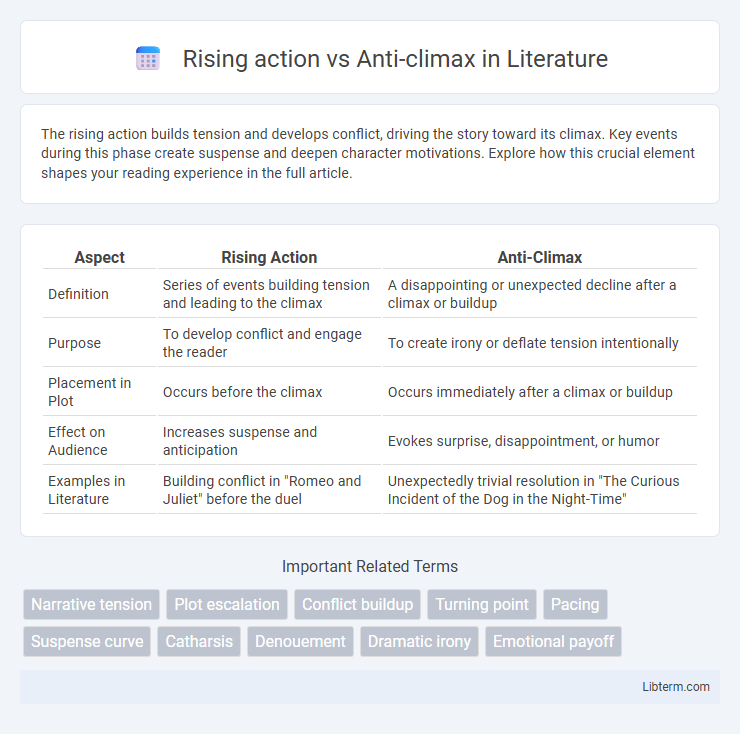The rising action builds tension and develops conflict, driving the story toward its climax. Key events during this phase create suspense and deepen character motivations. Explore how this crucial element shapes your reading experience in the full article.
Table of Comparison
| Aspect | Rising Action | Anti-Climax |
|---|---|---|
| Definition | Series of events building tension and leading to the climax | A disappointing or unexpected decline after a climax or buildup |
| Purpose | To develop conflict and engage the reader | To create irony or deflate tension intentionally |
| Placement in Plot | Occurs before the climax | Occurs immediately after a climax or buildup |
| Effect on Audience | Increases suspense and anticipation | Evokes surprise, disappointment, or humor |
| Examples in Literature | Building conflict in "Romeo and Juliet" before the duel | Unexpectedly trivial resolution in "The Curious Incident of the Dog in the Night-Time" |
Understanding Rising Action in Storytelling
Rising action in storytelling consists of a series of events that build tension and develop the central conflict, driving the narrative toward the climax. It deepens character motivations and escalates stakes, ensuring audience engagement through suspense and emotional investment. Understanding rising action is crucial for crafting compelling plots that maintain momentum and lead to satisfying resolutions.
Defining the Anti-Climax: Breaking Audience Expectations
The anti-climax subverts traditional rising action by abruptly deflating tension and shifting the narrative tone, often surprising or frustrating the audience. This narrative device breaks audience expectations by delivering an outcome that contrasts sharply with the built-up suspense or conflict. Understanding the anti-climax involves recognizing its role in challenging predictable storytelling structures and provoking critical reflection on the narrative's progression.
Key Differences Between Rising Action and Anti-Climax
Rising action refers to the series of events that build tension and develop the story's conflict, propelling the plot toward the climax. In contrast, an anti-climax occurs when the narrative unexpectedly drops in intensity, leading to a disappointing or trivial resolution instead of a peak moment. Key differences include rising action's role in heightening suspense and driving character development, whereas anti-climax typically undermines narrative expectations by deflating tension.
Narrative Impact: How Rising Action Builds Suspense
Rising action steadily intensifies conflict through a series of escalating events that heighten tension and engage the audience's curiosity, effectively propelling the narrative toward a climactic moment. This progression builds suspense by increasing stakes and complicating character choices, ensuring that viewers or readers are emotionally invested in the outcome. In contrast, an anti-climax disrupts this buildup by delivering an unexpected, often underwhelming resolution that deflates tension and subverts audience expectations.
The Role of Anti-Climax in Modern Literature
The role of anti-climax in modern literature subverts traditional rising action by deliberately deflating narrative expectations to highlight realism or irony. This technique contrasts with rising action's build-up of tension by delivering uneventful or unexpectedly mundane outcomes, enhancing thematic depth and character development. Contemporary authors use anti-climax to challenge conventional plot structures, emphasizing unpredictability and the complexity of human experience.
Common Examples of Rising Action
Common examples of rising action include a protagonist facing escalating challenges, such as Harry Potter's journey through magical trials or Frodo's perilous quest in "The Lord of the Rings." These events build tension and deepen conflict, driving the story toward its climax. Unlike anti-climaxes, which deflate expectations with unexpected downfalls, rising actions intensify suspense and emotional investment.
Famous Anti-Climax Moments in Film and Fiction
Famous anti-climax moments in film and fiction subvert audience expectations by delivering an unexpectedly disappointing or trivial resolution after intense buildup, such as the reveal of Darth Vader as Luke's father in *Star Wars* followed by the Empire's quick defeat, or the abrupt ending in *The Mist* where hope is cruelly crushed. These instances contrast sharply with rising action, which steadily escalates tension and stakes, aiming to keep viewers engaged and invested in the narrative outcome. Iconic anti-climaxes redefine storytelling dynamics by challenging traditional narrative arcs and leaving a lasting emotional impact through surprise and irony.
Techniques to Balance Rising Action and Resolution
Effective balancing of rising action and resolution employs pacing techniques such as escalating conflict intensity and strategic use of foreshadowing to maintain suspense. Incorporating controlled tension release through well-timed setbacks prevents readers from losing interest before the climax. Utilizing parallel plot threads and character development ensures a satisfying transition from rising action to resolution, avoiding an abrupt or anti-climactic ending.
Avoiding Unintentional Anti-Climax in Your Writing
Rising action builds tension by gradually escalating conflicts and challenges, driving the narrative toward a meaningful climax. Avoid unintentional anti-climax by ensuring the resolution meets or exceeds reader expectations, maintaining consistent stakes and pacing. Effective plotting balances suspense and payoff, preventing deflation of interest through premature or overly simplistic conclusions.
Choosing Between Rising Action and Anti-Climax for Story Effect
Choosing between rising action and anti-climax depends on the desired emotional impact and narrative pacing; rising action builds tension through escalating conflicts and stakes, driving readers toward a powerful climax, while an anti-climax deliberately deflates expectations, creating surprise or humor by resolving tension abruptly. Stories aiming to sustain suspense and investment benefit from a well-crafted rising action that deepens character development and plot complexity. Conversely, employing an anti-climax can subvert conventional storytelling, offering critical commentary or comedic relief by challenging audience anticipation.
Rising action Infographic

 libterm.com
libterm.com